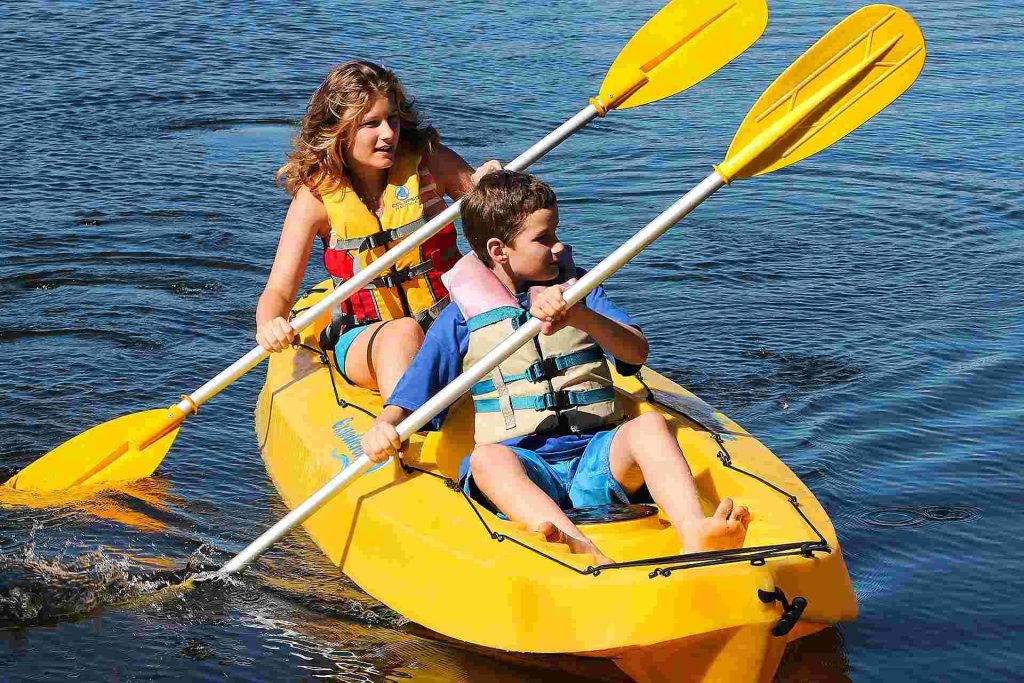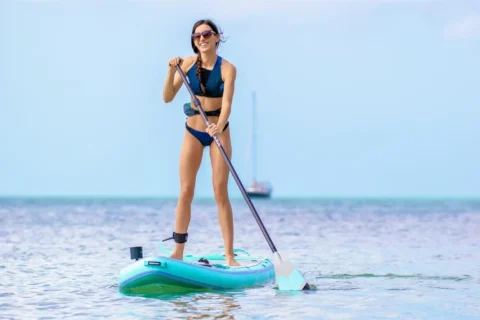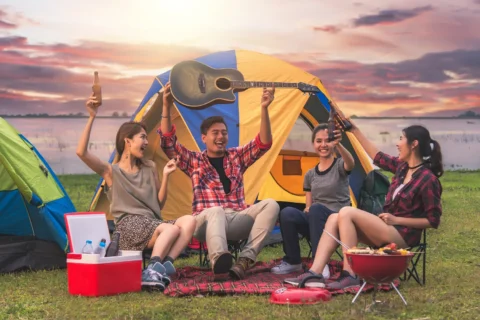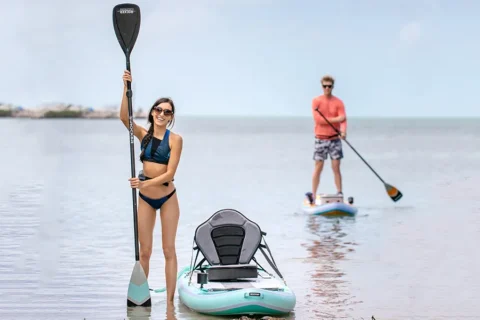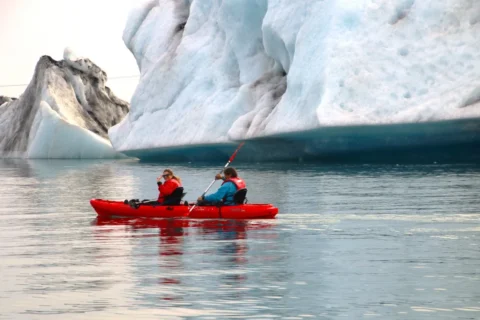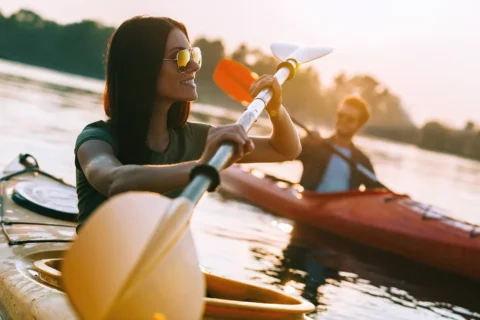Although there are all kinds of kayaks, the main thing we’re talking about here is recreational kayaking.
Leisure kayaks are also called “basic boats”. As the name suggests, they can be operated without much professional sailing knowledge, and are the easiest and easiest boats to learn.
There are two main styles of recreational kayaking:
a solo kayak (which only allows one person to paddle) or
a tandem kayak (which allows two people to paddle).
Kayaks also have two distinct style terms of their own: “Sit on top kayak” and “Sit in kayak.” These two kayaks combine the advantages of “plastic kayaks” and “inflatable boats”. “Plastic kayaks” are very popular, and they can be launched directly into the water. Inflatable boats are also popular. When we are not inflating, we can fold them up, which is very convenient for transportation.
There are a few differences between a “Sit on top kayak” and a “Sit in kayak,” but there’s still only a lot in common between them.
The top of the ship is called “cabin”, the bottom of the ship is called “hull”, the bow is called “bow”, and the stern is called “end”. In the “cabin” there are sealed compartments or storage compartments for fixing water bottles or sunshade, fixed handles are installed at the bow and stern, and some kayaks have some ropes for grabbing around, so that the boat can quickly become stable. Some kayaks also have rudders and fins, although these are not very sophisticated equipment, but they can better help the kayak to keep a straight line.
We can steer the rudder with our feet and make it turn in all directions. The tail fin is mounted along the centerline of the kayak, which keeps the kayak straight as it glides through the water. Both “sit on top kayak” and “sit in kayak” have special seats, and some kayaks have seats with backrests.
The most distinctive feature of the “sit in kayak” is the cockpit. There is a water retaining flange around the cabin, which is beneficial to prevent water from entering the cabin when rowing. What’s more, there are footrest installed in the cockpit, which can be adjusted according to the length of the feet of different rowers until the best condition. Of course, “sit on top kayak” also provide places for footrest, but there are some grooves. Individual rowers can place their feet in the grooves at various levels according to their needs until they fit. These grooves are so smooth and easy that the rower does not need to make manual adjustments.
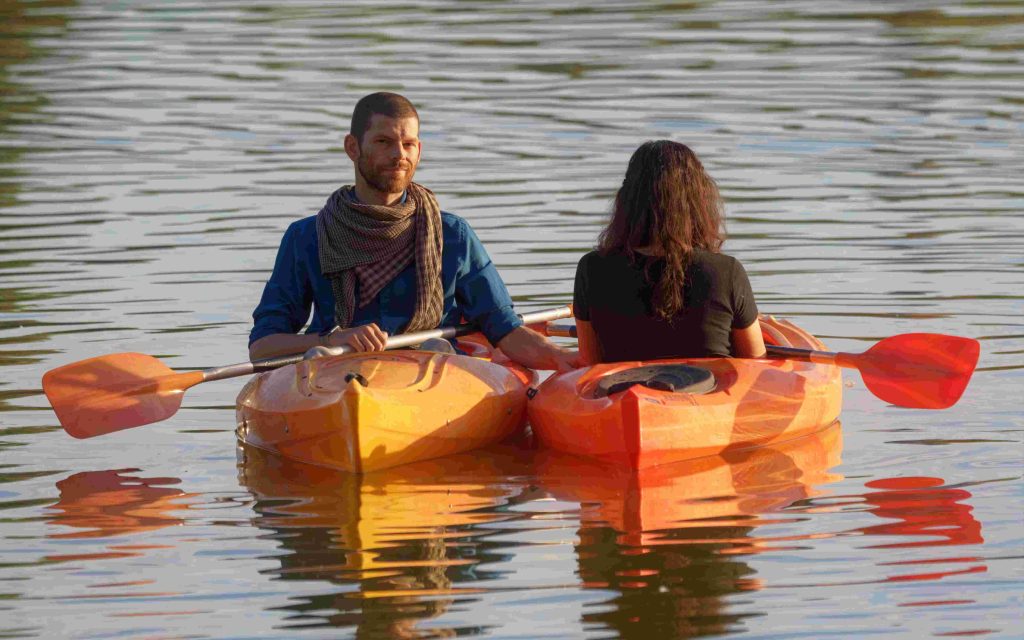
Recreational kayaks come in a variety of lengths. Before choosing, you must be clear:
where to kayak, and how much it costs.
Advantages and disadvantages of “Sit on top kayak” and “Sit in kayak”
Sit on top kayak are the easiest to learn of all boats. As long as you can get on the kayak safely, your feet can be freely stretched as you like, but the sit in kayak has no such advantages, and your feet will be greatly restricted in it. The sit on top kayak also has the function of self-drainage. When the boat enters the water, the water will be automatically discharged from the deck drain hole under the pedal. The “innate” stability of the sit on top will make you fall in love with it. You can turn up and down easily, even if your kayak capsizes in the water. You can easily climb back on the kayak just by turning it over.
Sit in kayakshould be the best choice for some players who don’t like to get wet. It is waterproof and windproof, and it is very popular in warm waters rather than extreme heat.
A cockpit boat is as smooth and easy to maneuver as a sit on top kayak. It all offers a well-fitting cockpit that minimizes stress and makes getting on and off the boat very easy. The last advantage of the sit in kayak is that it is made of a wide range of materials.
One thing to note is that in the water, you can’t jump up and down on the cockpit boat naturally. When it is overturned, it is a difficult process to restore it to its original state.
The main reason is that it has no self-draining holes, and once the boat capsizes, it will be submerged by someone, which is very bulky and difficult to handle.
Some sit in kayak are designed with flotation devices, that is, the cabin is equipped with waterproof panels that divide the interior into several independent compartments. These compartments are all connected to the deck, which not only prevents the kayak from being submerged when it capsizes, but also can store clothes and other things inside, and the waterproof performance is very good.
Whether you choose a sit on top or a sit in kayak, there are several questions for your reference. According to common sense: narrow and long kayaks are very fast, and wider boats are more stable. For tugboats and people transporting by car, the shorter the length of the kayaks, the lighter it will be, and it will be easier to transport.
From bow to stern, along the curve of the hull, we see some curved corners. The more arcs you have, the easier it is to steer the boat around the turn. If there are too few it is difficult to keep the kayak going in a straight line. Most recreational kayaks have lots of small curved corners to keep the boat going in a straight line. If you want to paddle in the surf, it is best to choose a kayak with a relatively large arc.
